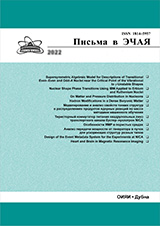FETAL ORGAN DOSE ASSESSMENT DURING CHEST CT EXAMINATION USING MONTE CARLO / GATE SIMULATION
Ключевые слова:
Fetus, pregnant, organ dose, simulation, Monte Carlo, Gate, Voxelized phantom, KatjaАннотация
A CT scan of a pregnant patient is often a source of distress for the patient and staff. Despite his expertise in image interpretation, the radiologist may not feel adequately equipped to discuss safety radiation issues during an examination of a pregnant woman. In addition, patients are usually worried about the risk of unfavorable effects on the fetus from radiation. Therefore, the assessment of radiation dose and related risk to the fetus and the pregnant patient is an important aspect of radiation protection. In this study, the GATE Monte Carlo (MC) toolkit was used to simulate a chest CT protocol model related to the voxelized phantom Katja representing a pregnant patient in the third trimester of gestation. The CT scanner type SOMATOM EMOTION 16 CT (Siemens Medical Solutions, Erlangen, Germany), was modeled to estimate fetal organ doses and effective doses with 80, 110 and 130 kV for 0.5, 0.6, 0.7, 0.9, 1 and 1.5 pitch using 10 mm slice thickness. Fetal effective doses were estimated to be 0.8, 1.7 and 2.4 mSv for 80 kV, 110 kV and 130 kV respectively. Fetal organ dose for heart and eye lens were found to decrease by 64.28% and 64.6% respectively between 80 kV and 130 kV. Moreover, the fetus organ dose was found to decrease by 21.5%, 19.2%, 30% and 17,6% for crane, eyes, heart and brain for a 0.5 and 1.5 pitch. Although the fetal doses were considered acceptable since cumulative dose to the fetus is estimated not to exceed 100 mGy.




